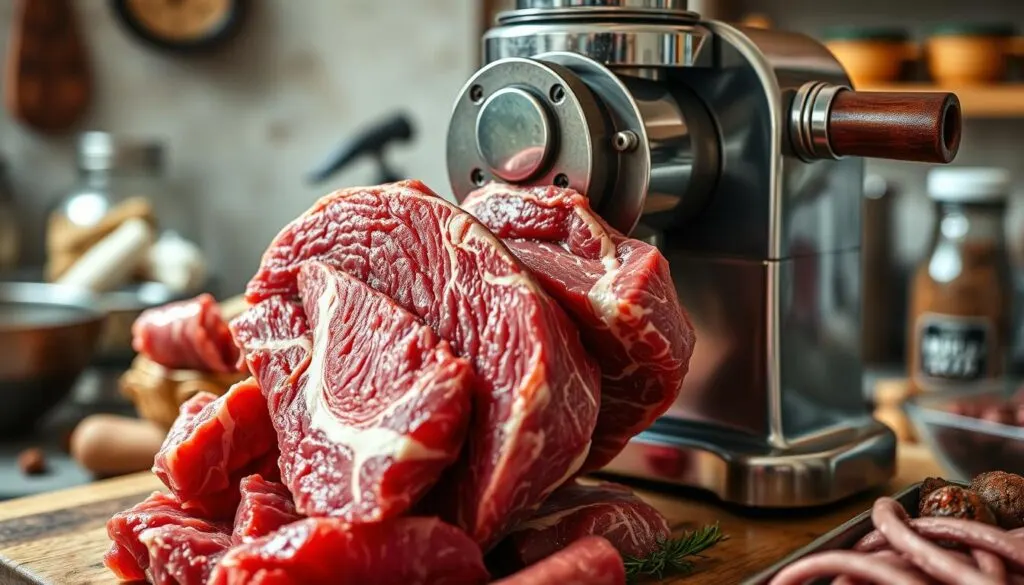The sizzle of freshly cooked breakfast sausage fills the kitchen with a delicious smell. The first bite is incredibly satisfying. Making your own beef breakfast sausage from scratch is the best way to enjoy these moments.
Let’s dive into the world of homemade sausage. We’ll learn how to make a breakfast staple that’s truly special.
Table of Contents
Understanding Beef Breakfast Sausage
Beef breakfast sausage is a tasty, protein-rich choice instead of pork sausage patties. It’s made from ground beef, mixed with spices. The mix includes kosher salt, black pepper, and more.
What Is Beef Breakfast Sausage?
Beef breakfast sausage is leaner and pork-free. It’s a great choice for a balanced breakfast. It’s full of savory protein, perfect for those who don’t like pork sausage patties or want a healthier morning meal.
Key Ingredients
- Ground beef (85% lean, 15% fat)
- Kosher salt
- Black pepper
- Onion powder
- Garlic powder
- Smoked paprika
- Dried thyme
- Dried sage
- Red pepper flakes (optional, for a touch of heat)
These ingredients blend to make a tasty breakfast sausage. It’s great on its own or in many breakfast dishes.
“Beef breakfast sausage is the perfect protein-packed addition to your morning routine, offering a delicious and healthy alternative to traditional pork sausage.”
Benefits of Making Sausage at Home
Making your own breakfast sausage at home has many benefits. You can pick the ingredients for a fresh, tasty start to your day with breakfast classics. You can also adjust the spice, fat, and seasonings to match your taste.
Control Over Ingredients
One big plus of making sausage at home is choosing top-quality ingredients. You can avoid preservatives and additives found in store-bought sausage. This lets you make a breakfast that fits your diet and taste.
Custom Flavor Profiles
Get creative with flavors when making sausage at home. Try classic breakfast spices like sage and thyme, or bold ones like cayenne and fennel. Making your own sausage lets you find the perfect flavor mix for a great hearty start.
“Homemade sausage is a game-changer for breakfast. The ability to control the ingredients and customize the flavors is truly unbeatable.”
Also, making sausage at home can save you money. Buying ingredients in bulk and mixing your own seasonings can cut costs. This way, you can enjoy your favorite breakfast classics without spending too much.
Tools and Equipment Needed
Making tasty breakfast meat and sausage links at home needs the right tools. A sausage grinder helps, but it’s not essential. You’ll need a few key items to start.
Sausage Grinder
A sausage grinder is handy for grinding beef. The LEM Big Bite Meat Grinder #22 is great for big batches. It can handle up to 15 pounds of meat per minute. For smaller kitchens, a meat grinder attachment for your KitchenAid stand mixer works too.
Mixing Bowls and Utensils
You’ll need a big mixing bowl for the ground beef and seasonings. Use a smaller bowl for mixing spices. You’ll also need measuring spoons, a sharp knife, and a sturdy spatula for cooking. For sausage links, you might need sausage casings and a stuffer.
| Equipment | Recommendation |
|---|---|
| Meat Grinder | LEM Big Bite Meat Grinder #22 |
| Meat Mixer | LEM Big Bite 25-Pound Meat Mixer |
| Sausage Stuffer | Hand Crank Sausage Stuffer or KitchenAid Attachment |
With the right tools, you can make delicious homemade breakfast meat and sausage links. They’ll surely please your taste buds.
Selecting the Right Cut of Beef
Choosing the right cut of beef is key to making perfect breakfast meat or savory protein. For homemade beef breakfast sausage, use ground beef with 15% fat. Leaner mixes, like 90/10, can make the sausage dry and crumbly.
You can also mix ground meats. Blend beef with pork or turkey to create unique flavors and textures. Grass-fed beef might have a special taste and more nutrients. But, either choice can be great for making sausage.
Best Cuts for Sausage
- Ground beef with 15% fat content
- Combination of ground beef and pork or turkey
Grass-Fed vs. Grain-Fed
Choosing between grass-fed and grain-fed beef depends on your taste and nutritional goals. Grass-fed beef might taste different and be more nutritious. Grain-fed beef gives a traditional sausage taste. Both are good for your homemade sausage.
| Cut of Beef | Fat Content | Recommended Use |
|---|---|---|
| Ground Beef | 15% Fat | Ideal for Sausage-Making |
| 90/10 Ground Beef | 10% Fat | Too Lean for Sausage |
| Grass-Fed Beef | Varies | Unique Flavor, Higher Nutrition |
| Grain-Fed Beef | Varies | Traditional Sausage Flavor |
Flavoring Your Sausage
Making tasty brunch fare or breakfast classics begins with the right spices and herbs. Knowing the key seasonings helps you make a sausage that’s truly special.
Essential Spices for Beef Breakfast Sausage
The base of a great beef breakfast sausage is a mix of spices. Here are the must-haves:
- Brown sugar: Adds a sweet touch that balances the savory.
- Dried sage: Gives a unique herbal smell and taste.
- Salt: Boosts the flavor and seasoning.
- Dried basil: Adds a mild, earthy flavor.
- Black pepper: Gives a warm, strong kick.
- Onion powder: Adds a mild onion taste that goes well with beef.
- Dried marjoram: Brings a subtle lemony, sweet flavor.
- Crushed red pepper flakes: Adds a bit of heat to balance the spices.
Herbs That Enhance Flavor
Adding fresh or dried herbs can elevate your homemade sausage. Try these:
- Thyme: Offers a fragrant, earthy taste.
- Sage: Adds a warm, slightly peppery flavor.
For a smoky flavor, use smoked paprika. Adjust the cayenne or red pepper flakes for heat. Try garlic powder or cloves for unique flavors.
“The secret to a truly outstanding beef breakfast sausage lies in the perfect balance of spices and herbs.”
– Joanne Gallagher, Recipe Developer
Preparing the Beef
When making your own breakfast meat, the prep stage is crucial. Before grinding, trim any extra fat to get 15-20% fat content. This ensures your breakfast sausage is juicy and flavorful.
Grind the beef yourself? Chill the meat and grinder parts first. This keeps the beef’s texture and prevents fat smearing. For pre-ground beef, just chill it in a large bowl without overworking it.

Trimming the Fat
Examine the beef and trim off any extra fat or connective tissue. This step is key for a breakfast sausage with the right mix of savory protein and fat. It makes your sausage juicy and full of flavor.
Grinding the Beef
Grinding the beef yourself? Chill it and the grinder parts first. Grind the beef carefully, avoiding overworking it to prevent toughness. For pre-ground beef, just chill it and move on to the next step.
“The key to making delicious homemade breakfast sausage is paying close attention to the preparation of the beef. Trim the fat, chill the grinder, and handle the meat gently to ensure a tender, juicy final product.”
Mixing Your Sausage
Mixing the perfect homemade beef breakfast sausage is key. This is where you mix ground beef with aromatic seasonings. It’s all about even flavors and tender texture.
Combining Meat and Seasonings
In a large bowl, mix ground beef with your spice blend. Use sea salt, black pepper, sage, paprika, marjoram, and red pepper flakes for that classic taste. Mix gently with your hands to avoid tough sausages.
Ensuring Even Distribution
Add 1/4 cup of cold water or apple juice to the mix. This makes the sausage softer and more cohesive. Mix well, then refrigerate for 24 hours to let the flavors blend.
“Making sausage at home involves adding seasonings to ground meat, with common ingredients for country breakfast sausage including sea salt, black pepper, sage, paprika, majoram, and red pepper flakes.”
Follow these steps for a hearty start with homemade beef breakfast sausage. Mix gently and let the flavors meld overnight. You’ll get a breakfast classic that’s delicious.
Stuffing the Sausage (Optional)
This recipe is great for making sausage patties, but you can also make breakfast sausage links. Just fill seasoned beef into sausage casings for a classic look. Or, shape it into patties by spreading it thin and cutting out rounds.
For something different, make small meatballs or use it in other breakfast dishes.
Using Sausage Casings
Sausage casings make it easy to make bite-sized breakfast sausage links. Fill them with your sausage mixture, twist into links, and cook until done. This way, you get the classic sausage shape and texture.
Alternative Formations
Want a patty-style sausage? Just shape the mixture into rounds. This lets you control the size and makes cooking easy. You can also shape it into meatballs or add it to breakfast dishes like quiches or sandwiches.
| Sausage Formation | Yield | Cooking Time | Nutrition (per serving) |
|---|---|---|---|
| Sausage Links | 6 servings | 12-15 minutes | 240 calories, 15-20g protein |
| Sausage Patties | 6 servings | 8-10 minutes | 220 calories, 18g protein |
| Meatballs | 12 servings | 15-20 minutes | 180 calories, 12g protein |
Choosing how to shape your sausage links or breakfast meat lets you control the taste and size. Try different shapes to find what works best for you.
Cooking Methods for Beef Breakfast Sausage
Once you’ve made your homemade beef breakfast sausage, it’s time to cook it right. You can pan-fry or grill these tasty protein-packed classics.
Pan-Frying
Pan-frying is a classic way to cook beef breakfast sausage. Heat a big skillet over medium heat. Add the sausage patties and cook for 4-5 minutes on each side. This makes the sausage brown and safe to eat at 160°F.
For an easier option, cook the sausage in an air fryer at 400°F for 7-9 minutes.
Grilling
Grilling is great for cooking beef breakfast sausage, especially for bigger patties or links. Heat your grill to medium-high. Cook the sausage until it’s 160°F, about 6 minutes on each side. This adds a smoky flavor and crispy outside.
Whether you grill or pan-fry, let the sausage rest for a few minutes before serving. This makes sure every bite is juicy and full of flavor.
| Cooking Method | Cook Time | Internal Temp | Benefits |
|---|---|---|---|
| Pan-Frying | 4-5 minutes per side | 160°F | Traditional method, easy cleanup |
| Air Frying | 7-9 minutes at 400°F | 160°F | Healthier option, quick and convenient |
| Grilling | 6 minutes per side | 160°F | Adds smoky flavor, great for larger cuts |
Always cook your homemade beef breakfast sausage to 160°F for safety and flavor. With these methods, you can enjoy tasty breakfast classics anytime.

Storage Tips for Homemade Sausage
Keeping your homemade beef breakfast sausage fresh and tasty is important. The right storage methods help keep it good for longer. This way, you can enjoy a delicious start to your day.
Freezing the Sausage
Freezing is the best way to store your sausage for a long time. Place the patties on a baking sheet lined with wax paper and freeze them. Then, move them to a freezer bag or container.
Stored right, your sausage can stay in the freezer for up to 2 months. Just thaw it in the fridge overnight before cooking.
Refrigeration Guidelines
For eating your sausage in a few days, refrigeration is best. Cooked patties can stay in the fridge for 3-4 days. Uncooked sausage should be used within 1-2 days.
Make sure your fridge stays at or below 40°F (4°C). This keeps your sausage safe and tasty.
| Item | Refrigerator (40°F or below) | Freezer (0°F or below) |
|---|---|---|
| Cooked Sausage Patties | 3-4 days | 1-2 months |
| Uncooked Ground Sausage | 1-2 days | 2-3 months |
When it comes to ground meat, be careful. If it smells bad, looks off, or feels slimy, throw it away. It’s better to be safe than sorry.
By storing your sausage right, you can enjoy it for days or weeks. This makes for a hearty start to your day.
Health Considerations
It’s key to watch your portion sizes and balance your diet when eating beef breakfast sausage. A single patty can give you a protein-rich start. But, it’s important to control how much you eat for a healthy lifestyle.
Nutritional Value of Beef Breakfast Sausage
One beef breakfast sausage patty has about 215 calories, 14 grams of fat, 2 grams of carbs, and 19 grams of protein. It’s a filling start but also adds 18% of your daily fat, 27% of saturated fat, and 24% of cholesterol.
Managing Portion Sizes
- Balance your breakfast with one sausage patty, eggs, and veggies.
- Choose leaner beef to lower fat in your homemade sausage.
- Combine sausage with whole grains, fruits, and veggies for a balanced meal.
| Product | Saturated Fat | Sodium | Protein |
|---|---|---|---|
| Chicken & Apple Smoked Chicken Sausage (Aidells) | 18% DV | – | – |
| Applegate Naturals Classic Pork Breakfast Sausages | – | 17% DV | – |
| Alfresco’s Sweet Italian-Style Chicken Sausage | 8% DV | – | – |
| Johnsonville’s Brown Sugar & Honey Breakfast Sausage | 24% DV | – | – |
| 365 by Whole Foods Market Sausages | – | – | 12g |
By controlling portion sizes and choosing leaner beef, you can enjoy the protein and hearty start of homemade sausage. This way, you keep your diet balanced and healthy.
Creative Serving Suggestions
Make your breakfast better by adding homemade beef sausage to classic dishes. Try it with fluffy scrambled eggs, toasted whole grain bread, or almond flour biscuits. For a full brunch, add fresh berries or a side salad to cut the sausage’s richness.
Pairing with Breakfast Classics
Your homemade beef sausage is great with many breakfast favorites. Put it in a breakfast sandwich or burrito for a tasty, easy meal. Add it to a breakfast pizza or quiche for a savory touch. Or, serve it with mashed cauliflower or roasted veggies for a healthy, tasty option.
Using in Unique Recipes
Try new things with your homemade beef sausage. Enjoy cold sausage with Dijon mustard or sriracha mayo for a tasty snack. Use it in a cloud bread sandwich for a keto-friendly burger. The possibilities are endless for showcasing your sausage in brunch dishes and unique recipes.
FAQ
What is beef breakfast sausage?
What are the key ingredients in beef breakfast sausage?
What are the benefits of making sausage at home?
What tools and equipment are needed to make beef breakfast sausage?
What is the best cut of beef for breakfast sausage?
How do I prepare the beef for sausage-making?
How do I cook beef breakfast sausage?
How do I store homemade beef breakfast sausage?
What are the health considerations for beef breakfast sausage?
Source Links
- Easy Beef Sausage Recipe – Healthy Recipes Blog – https://healthyrecipesblogs.com/homemade-sausage/
- Breakfast Sausage Patties – Healthy Recipes Blog – https://healthyrecipesblogs.com/homemade-breakfast-sausage/
- Breakfast Sausage From Ground Beef | Kitchen Hack | How to Make a Breakfast Sausage Substitute! – The Home in Homestead – https://thehomeinhomestead.com/breakfast-sausage-from-ground-beef/
- Homemade Beef Breakfast Sausage – https://thecookful.com/beef-breakfast-sausage/
- Beef Breakfast Sausage: Savory Morning Delight – https://onestophalal.com/blogs/info/savoring-the-flavor-exploring-the-allure-of-beef-breakfast-sausage
- Homemade Breakfast Sausage Made Easy – https://www.psseasoning.com/blogs/news-events/homemade-breakfast-sausage-made-easy?srsltid=AfmBOoqUhCrJyJOT4qpfNDSk9cdxAgEyAdJn8WM3NnXmHw0Av5dnK1QM
- Easy Homemade Breakfast Sausage Recipe – healthy – https://blog.memeinge.com/breakfast-sausage/
- How to Make Sausage At Home – https://www.smokedbbqsource.com/how-to-make-sausage-at-home/
- Homemade Breakfast Sausages – https://thecookful.com/homemade-breakfast-sausages/
- Wild Game (Moose) Breakfast Sausage Recipe – https://happyhomealaska.com/breakfast-sausage-recipe/
- How to Make Homemade Breakfast Sausage Links – https://www.smokedbbqsource.com/homemade-breakfast-sausage/
- Sausage Showdown: Choosing the Perfect Sausage for Your – Butcher – https://butcherbbq.com/blogs/news/sausage-showdown-choosing-the-perfect-meat-for-your-bbq?srsltid=AfmBOopfjNGtxpsEeZBS4nlmdQ0jpAYJIEhr4hoFUohEQ0Dkus1k5gtv
- Easy Homemade Beef Breakfast Sausage Recipe – https://www.tastemeats.com/beef-breakfast-sausage/
- Best Breakfast Sausage Seasoning – Evolving Table – https://www.evolvingtable.com/breakfast-sausage-seasoning/
- Seriously Good Breakfast Sausage – https://www.inspiredtaste.net/82065/breakfast-sausage-recipe/
- Spicy Breakfast Sausage – https://www.lanascooking.com/spicy-breakfast-sausage/
- Breakfast Sausage Seasoning Recipe – https://thecookful.com/breakfast-sausage-seasoning-recipe/
- Best Baked Beans with Sausage and Ground Beef – https://saladinajar.com/recipes/hearty-baked-beans/
- The Best Homemade Country Breakfast Sausage Recipe – Health Starts in the Kitchen – https://healthstartsinthekitchen.com/country-breakfast-sausage-recipe/
- Homemade Breakfast Sausage Made Easy – https://www.psseasoning.com/blogs/news-events/homemade-breakfast-sausage-made-easy?srsltid=AfmBOopb5-qNuikka71Z4HAodtvsS44hpB__ck_ERixeFWt_S63e4pCs
- Flavorful Sausage Stuffing – Healthy Recipes Blog – https://healthyrecipesblogs.com/sausage-stuffing/
- Buttery Herb and Sausage Stuffing – https://handmadefarmhouse.com/buttery-herb-and-sausage-stuffing/
- Beef Breakfast Sausage: Recipes, Nutrition, and Cooking Tips – https://alyarecipes.com/beef-breakfast-sausage/
- Why Beef Breakfast Sausage Is The Ultimate Breakfast Choice – https://www.meatplatesrecipes.com/beef-breakfast-sausage/
- I Tried Cooking Sausage 3 Ways—This One Was the Best – https://www.realsimple.com/food-recipes/how-to-cook-sausage
- Homemade Italian Sausage (Whole30, Paleo, Gluten Free) – https://nomnompaleo.com/homemade-italian-sausage
- How Long Does Ground Sausage Last In The Fridge? • Steamy Kitchen Recipes Giveaways – https://steamykitchen.com/242896-how-long-does-ground-sausage-last-in-the-fridge.html
- Sausage Brands With The Best And Worst Ingredients – Chowhound – https://www.chowhound.com/1591213/sausage-brands-ingredients-quality/
- 5 Healthy Breakfast Meats + What to Avoid | Nourish – https://www.usenourish.com/blog/healthy-breakfast-meats
- 37 Savory Breakfast Sausage Recipes – https://www.tasteofhome.com/collection/breakfast-sausage-recipes/?srsltid=AfmBOor-hU7XyKNdGINDGav6aShPdsGdZUTBDDzddnpPUzE-DDlbEcLV
- 15 Creative Ways to Use Sausage Crumbles In Everyday Cooking – The Survival Mom – https://thesurvivalmom.com/how-to-use-sausage-crumbles/
- Beef Breakfast Sausage: Easy & Delicious Recipe – https://www.anydayrecipes.com/beef-breakfast-sausage/
Did You Try This Recipe ?
There are no reviews yet. Be the first one to write one.








